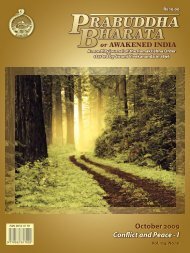P
PB Cover July 2011.indd - Advaita Ashrama
PB Cover July 2011.indd - Advaita Ashrama
- No tags were found...
You also want an ePaper? Increase the reach of your titles
YUMPU automatically turns print PDFs into web optimized ePapers that Google loves.
Significance of the Term Putra in Vedic Literature<br />
53<br />
name given to the grown-up daughter, whose<br />
occupation had significance. The duhitā does<br />
the milking of cows, which was considered to<br />
be one of the primary and prestigious occupations<br />
in agricultural and pastoral families. The<br />
cow was a source of rāyi, wealth, as it gives milk,<br />
which the duhitā extracted. The duhitā was also<br />
named so because the parental wealth that she<br />
inherited was extracted from her parents and<br />
taken along with her to another family after<br />
marriage. Usha is the duhitā of the sun and its<br />
essence, and is called so because she extracts the<br />
sun’s property of light (3.53.15, 1.116.17, 1.117.13).<br />
The duhitā of Agni is again said to be the day or<br />
the dawn personified in Usha (1.71.5). Agni has<br />
the property of heat and light; the innermost<br />
core of his flames is his hottest part, while his<br />
soft and mellow radiation reveals the blue and<br />
red of the dawn, Usha. Therefore, Agni’s heat<br />
and light is wrung out by Usha to dispel the<br />
night. In yet another hymn both the day and<br />
the night are said to be duhitarā, daughters, of<br />
the sun (6.49.3). The sun contains both the day<br />
and the night.<br />
In the tenth mandala of the Rig Veda we<br />
find Daksha as the putra of Aditi, the mother,<br />
who in turn is the duhitā of Daksha (10.72.5).<br />
Aditi, the mother, is not dead but lives in Daksha,<br />
her putra, and becomes his duhitā in turn.<br />
So a duhitā can be mother and daughter at the<br />
same time. This includes the occupational definition<br />
of putra. While we have seen before that<br />
putra—put-tra—means also to procreate, to<br />
save, this function becomes important in the<br />
Brihadaranyaka Upanishad and in texts like<br />
the Kaushitaki Brahmana Upanishad, through<br />
which we can realize that Aditi is at the same<br />
time a mother and daughter; as mother she<br />
gives birth to Daksha, who in turn becomes<br />
the father of Aditi. The Upanishad says that<br />
when the father dies, he transmits his speech,<br />
PB July 2011<br />
mind, and life into the offspring and becomes<br />
immortal. In the Kaushitaki Brahmana Upanishad<br />
too it is said that the father lives in his<br />
child. Hence the idea of Aditi being both the<br />
mother and daughter of Daksha is reasonable.<br />
In a verse of the Rig Veda Sachi says: ‘Mama<br />
putrāḥ śatruhano’tho me duhitā virāt ; my sons<br />
are the slayers of my enemies, my daughter is<br />
an empress’ (10.159.3). This means that Sachi’s<br />
duhitā may have been singled out from all her<br />
valorous children due to her noble work of<br />
milking the cow in addition to fighting wars<br />
and killing foes, the mother herself participating<br />
in the latter act. Or the duhitā may not<br />
have been one of her children but an employee<br />
who did this work and was considered praiseworthy<br />
and honourable. In a hymn of the Rig<br />
Veda occurs: ‘putriṇā tā kumāriṇā; youthful<br />
and adolescent offspring’ (8.31.8). This is H H<br />
Wilson’s translation, but Griffith translates it<br />
as: ‘with sons and daughters.’ 29 The want for<br />
puṁsaḥ putram, male offspring, is expressed in<br />
the first mandala of the Rig Veda.30 Secondly<br />
sūnu, toka, tanaya, apatya are all general terms<br />
used in the Rig Veda as putra is used. While<br />
toka literally means the seed that can grow into<br />
either sex, tanaya—often compounded with<br />
toka—means child. The word apatya can be<br />
split into apa-tya, which carries the meaning<br />
of ‘going beyond ’.31 In sūnu the root su means<br />
‘to bring forth’ or ‘to give birth to’, and clearly<br />
points towards ‘child ’. Though the desire for a<br />
female offspring is not mentioned separately in<br />
the Rig Veda, the female child growing into the<br />
unmarried duhitā or the married or marriageable<br />
kanyā were held in great esteem.<br />
The urge for a male offspring might have<br />
come from other societies or races of a definite<br />
character, with whom the Aryans intermixed<br />
and produced an amalgam of cultures that incorporated<br />
the preferences of those cultures. The<br />
513
















